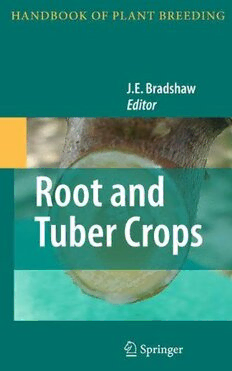
Root and Tuber Crops PDF
310 Pages·2010·7.422 MB·English
Most books are stored in the elastic cloud where traffic is expensive. For this reason, we have a limit on daily download.
Preview Root and Tuber Crops
Description:
Root and Tuber Crops John Bradshaw Editor A number of root and tuber crops were first domesticated several thousand years ago, but none became important on a global scale until after the end of the 16th century. Today the potato is the world’s third most important food crop (314 million tonnes produced in 2008), after wheat and rice. Cassava (233) is the most important root and tuber crop in the tropics where it is a primary staple food in many of the poorest countries, and the sweet potato (110) is also a food staple in Asia, Africa and America. Sugar beet (228) provides about one quarter of the world’s sugar production from crops grown in temperate climates. Yams (52) are also important staple food crops in tropical and subtropical regions. Although Taro and Cocoyam are minor crops, they do provide a staple food for poor people in Africa, Asia and America. From the 1800s, fodder beet, swedes and turnips became important for feeding to livestock in temperate climates but they have now been replaced as major crops for animal feed by cereals and silage. The extent to which root and tuber crops are benefiting from modern breeding methods and new biotechnologies reflects both their own economic importance and that of their close relatives. All of this is covered together with past achievements, current breeding objectives and utilization of genetic resources. The book will be of value both to students of plant breeding and professional plant breeders, as well as to anyone interested in this fascinating group of root and tuber crops. The Handbook of Plant Breeding-Root and Tuber Crops is a volume devoted to 10 of the most important root and tuber crops and is divided into eight chapters: Potato (Solanum tuberosum), Cassava (Manihot esculenta), Sweet Potato (Ipomoea batatas), Yams (Dioscorea spp.), Taro (Colocasia esculenta) and Cocoyam (Xanthosoma sagittifolium), Sugar Beet (Beta vulgaris), Fodder Beet (Beta vulgaris), and Swedes (Brassica napus) and Turnip (Brassica rapa). Chapters have been written by experts on the crops with wide knowledge of their breeding. In order to provide uniformity with the other volumes in the Handbook of Plant Breeding, each chapter is divided into the following sections: Introduction, Origins and Domestication, Varietal Groups (where appropriate), Genetic Resources, Major Breeding Achievements, Current Goals of Breeding, Breeding Methods and Techniques, Integration of New Biotechnologies in Breeding Programs and Seed (Tuber/Commercial) Production. About the Editor: John Bradshaw is a Honorary Fellow of the Scottish Crop Research Institute, having spent the whole of his 34 year career there as a plant breeder and geneticist. Throughout his career he has been a member of the European Association for Research on Plant Breeding (EUCARPIA) and served as Chairperson of the Section Potatoes. He has travelled widely and written extensively on plant breeding, as well as serving on the editorial boards of a number of scientific journals.
See more
The list of books you might like
Most books are stored in the elastic cloud where traffic is expensive. For this reason, we have a limit on daily download.
